Surimi was not supposed to be a product. It is a technique, of finely cutting or grinding meat. The resulting paste can then be molded into various forms. If you know of surimi, you probably are familiar with the imitation crab meat mini logs. A rectangular shape with a springy texture and a faint red color gradient wrapped in plastic, an inexpensive fish repurposing product that was industrialized in 1969, in Japan. Approximately 2-3% of the world’s consumed fish is in the convenient form of surimi. Low-cost unfamiliar fish such as Alaska Pollock, milkfish, and Big-head pennah croaker are repurposed into nifty logs.

Various Surimi shapes.
From Wikipedia: “Lean meat from fish or land animals is first separated or minced. The meat then is rinsed numerous times to eliminate undesirable odors. The result is beaten and pulverized to form a gelatinous paste. Depending on the desired texture and flavor of the surimi product, the gelatinous paste is mixed with differing proportions of additives such as starch, egg white, salt, vegetable oil, humectants, sorbitol, sugar, soy protein, seasonings, and enhancers such as transglutaminases and monosodium glutamate (MSG).”
If the surimi is to be packed and frozen, food-grade cryoprotectants are added as preservatives while the meat paste is being mixed. Under most circumstances, surimi is processed immediately into a formed and cured product…
Typically the resulting paste, depending on the type of fish and whether it was rinsed in the production process, is tasteless and must be flavored artificially. According to the United States Department of Agriculture National Nutrient Database, fish surimi contains about 76% water, 15% protein, 6.85% carbohydrate, and 0.9% fat.”
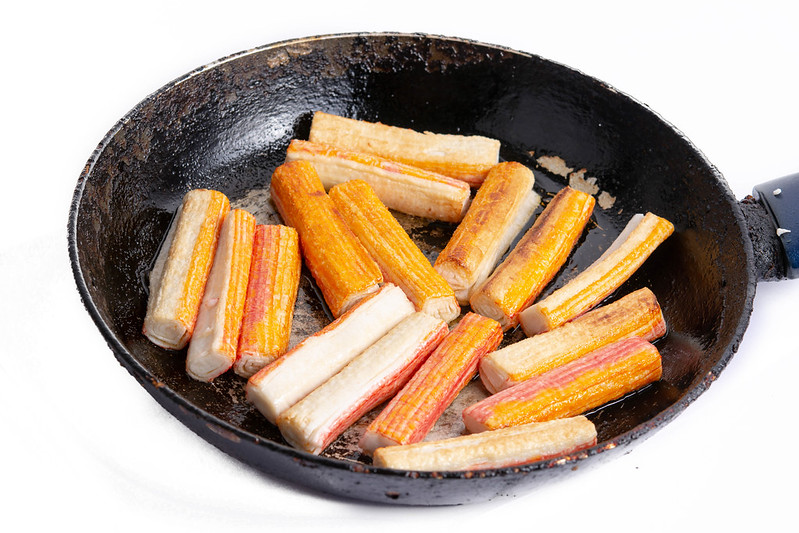
I didn’t know that it could get any worse.
Yummy. The 76% water content should be the thing that catches your eye here. From a profitability standpoint, that’s amazing. Like a fish in water. Surimi is a product for our times, an efficient industrialized product with high margins that could be made anywhere. Water pretending to be fish pretending to be a crab through a ridiculously industrial shape.
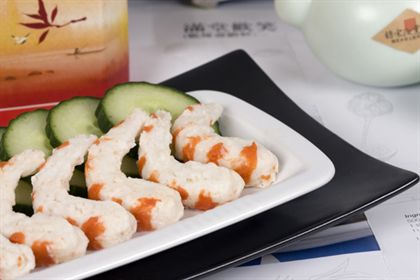
A Vegan Prawn dish tastes a bit like cleaned socks.
In Asian supermarkets, you can often find vegan imitation shrimp, as well. These are molded into a shape vaguely reminiscent of a gamba or langoustine. One of these products has as its ingredients as “water 75.75%, potato starch 8%, konjac powder 7%, kelp extract, sugar, wheat fiber, salt, non-GMO soy protein powder, paprika colors (E160c).” That particular one was a PETA VEGAN FOOD AWARDS 2015 winner for Best Faux Seafood.
Fish balls are also an Asian supermarket staple. These Southeast Asian and Chinese balls are often used in breakfast soups called congees, but they can also be found in regular soups or fried in many countries in the region. They are made in much the same way as surimi and are versatile, like the fake crab meat sticks. They are also both rather tasteless and textureless.
It’s like chewing red TPU with a vague hint of something sea-ish. Or it’s a bit like eating an ocean marinated Nike Air Max sole. Remember the movie Cast Away? It would be what Wilson tasted like. As well as being versatile, rather taste-free, these products are also inexpensive for the consumer, cheap to make, industrial, without origin, high-volume, global products. They are inexpensive sources of protein that can be sold frozen or chilled for around $4 to $10 a kilo to end consumers.
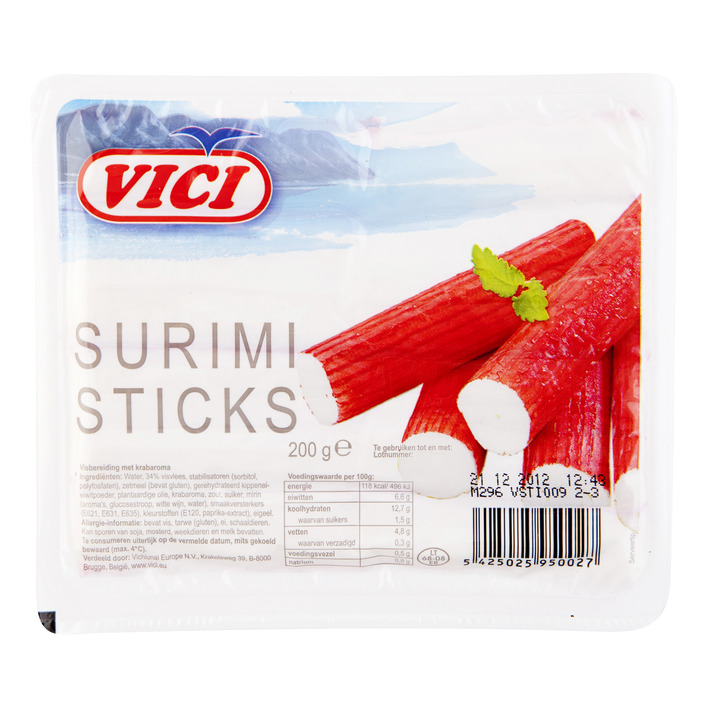
These are round and 0.79 Eurocents for 200 grams retail in the Netherlands .
As we’ve discussed previously, meat protein is becoming increasingly expensive, and alternatives are sought. A wave of startups is making fake meat steaks and burgers. Fake fish will be upon us, as well. Indeed we have FelixPrinters working on 3D printing fish, while Redefine Meat and Novameat print steak, the Foodini extrudes much else and the ChefJet aims to 3D print sugar treats. By going after high-value proteins, such as steaks and salmon, some of these companies are generally targeting the most expensive products.
Their methods are either using bioprinting techniques to print cells or taking a protein paste and shaping it through extrusion. Both of these main techniques have much to offer the billions in investor money directed at the meatless meat world. With bioprinting, we may via jetting, depositing, extrusion, SLA, SLS or inkjetting (an overview can be found here while this article looks at the future), be able to create a better burger or anything else really. Without resorting to the difficult vascularization step that limits bioprinting, we will be able to print an actual steak cell into a bioficial steak or similar. We would assume that this would give us a more true-to-life result than other means, since we’re recreating the tissue cell-by-cell directly or using scaffolds.
I think that it’s utterly hilarious that all of the startups now are focussed on creating a raw product that then has to be cooked and, in both states, needs to approximate the real meat even whilst we consume it cooked. I call this transformer food. Because, ultimately, why not create a steak that does not have to be cooked? Or perhaps create one that already tastes perfect, but you have to char it on the grill or take a cooking torch to it to finish it? That would be much simpler, probably taste better and be super fun to do, as well.
The transformer food problem, of course, is that it could be neither fish nor meat as the Dutch expression goes. A more sous vide-inspired, torch-able food would be much more logical. This notwithstanding, 3D printed food should have a better texture than that solely being made through industrial mixing or extrusion.

Really, how much cooler would this be?
3D printed extruded food should also be superior. If we both have the same food mix and brand, but you can get a slightly better exterior or interior texture then you will win. We, as a technology, excel in texture. We can make textures in or on things at will. We can make a thing look random, we can make it feel just right, and we can vary this property throughout the bite. Layer by layer we’ll create all of your mouthfeels for you, you Top Chefs.
If you want your burger to have different bites or shears throughout, we can do that through 3D printing. We could make different regions taste differently or give every steak a unique look while marbling it just right for one oven or pan. We could mix up fat and sinew to make it more appealing to the old or young or Malaysian or Belgian within the same process. We could easily print in nutrients, salts, or colorants. We could change the shape of salts and flavorings to make a lower dose of salt taste saltier. We could make flank one minute and ribeye the next according to trend or demand. Either through 3D printed extruded forms or through printing cells we will be the lever that will let firms win in the meatless food wars.
By just adding one texturization step to your process through 3D printing or by turning to 3D printing as a manufacturing technology for your recipe, we can make the difference. So, we find ourselves with a nascent food 3D printing industry that has stubbornly refused to take flight but has soaring pent up potential. This is especially so since everything can be surimi and surimi can be everything.
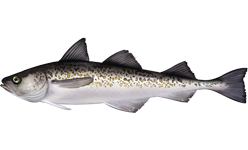
Ceci N’est pas un Crabe
Any fish can be used for surimi. Are we overfishing whiting? Use round eye. No more cod? Use bass or catfish or maybe not even fish? Surimi is the perfect industrial product because of its versatility, low cost, industrial production, high volume, global, no origin nature. It is the opposite of Champagne because we will never know where the fish came from, where it was made, how it was made, and of what it was made. Soylent Green for fish. But, if we look at the 75% water colored molded fish ball/surimi/fake shrimp product family, we realize that it is horrifyingly compelling because surimi can be everything.
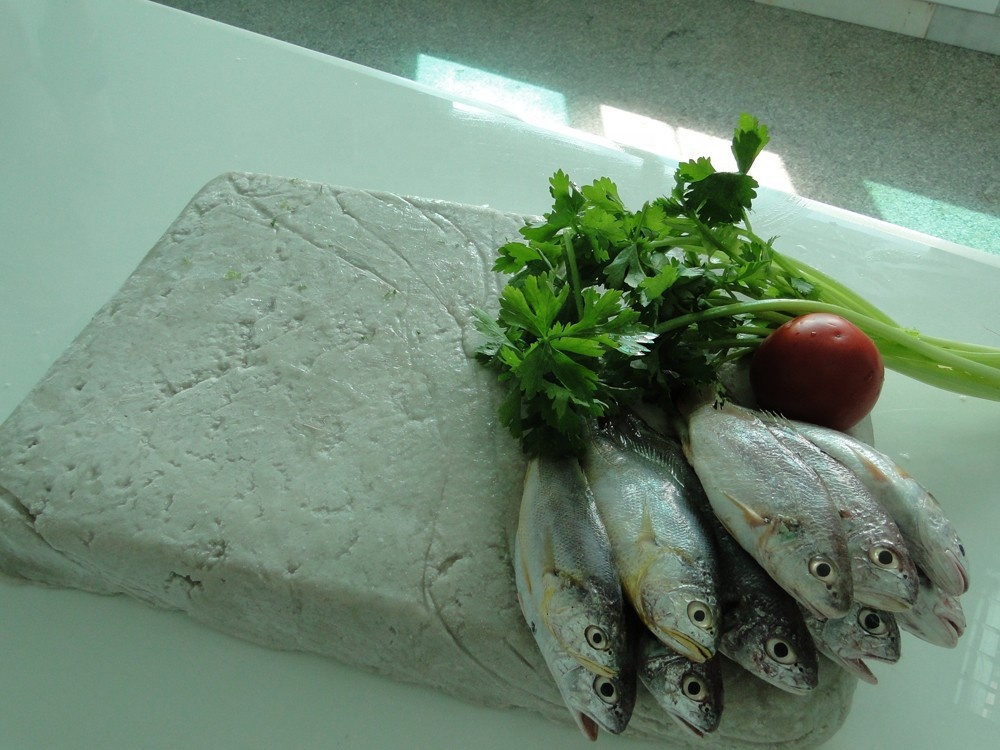
Blocks of fish that can be packaged into surimi sticks available for 1500 per metric tonne on AliBaba. Nom nom nom.
You could make a surimi of pates, sausages, tomatoes, melons, strawberries, nuts, soups, gels, sauces, candies, desserts, potatoes, syrups, milks, olives, cherries, dates, fried doughs, bananas, mangoes, avocados, grapes, champignons, dried ceps, apples, lemons, oranges, carrots, cucumbers, bacon, ham, smoked fish, canned tuna, tuna, cheese-like things, raisins and much much more. Of many things, it is possible to manufacture an industrialized, relatively tasteless 75% water containing ersatz surimi product variant. “Meatless” low-cost alternatives could replace many of the products that we eat. Meatless as well seems like it is to be a clarion call for a full-on assault on our food system by the VC-set. Meanwhile, the key to making these products feel and taste more like the ones they replace, is probably 3D printing.
By adding texture, structure, bite, variety, and production flexibility to foods the tiny 3D printed food industry could play a major role in the rocket ship that is the meatless meat industry.
Images: Tim Reckmann & Marco Verch.
Subscribe to Our Email Newsletter
Stay up-to-date on all the latest news from the 3D printing industry and receive information and offers from third party vendors.
You May Also Like
Profiling a Construction 3D Printing Pioneer: US Army Corps of Engineers’ Megan Kreiger
The world of construction 3D printing is still so new that the true experts can probably be counted on two hands. Among them is Megan Kreiger, Portfolio Manager of Additive...
US Army Corps of Engineers Taps Lincoln Electric & Eaton for Largest 3D Printed US Civil Works Part
The Soo Locks sit on the US-Canadian border, enabling maritime travel between Lake Superior and Lake Huron, from which ships can reach the rest of the Great Lakes. Crafts carrying...
Construction 3D Printing CEO Reflects on Being Female in Construction
Natalie Wadley, CEO of ChangeMaker3D, could hear the words of her daughter sitting next to her resounding in her head. “Mum, MUM, you’ve won!” Wadley had just won the prestigious...
1Print to Commercialize 3D Printed Coastal Resilience Solutions
1Print, a company that specializes in deploying additive construction (AC) for infrastructure projects, has entered an agreement with the University of Miami (UM) to accelerate commercialization of the SEAHIVE shoreline...





























